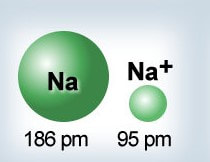

Slow-rotating and non-accreting neutron stars are difficult to detect, due the absence of electromagnetic radiation however, since the Hubble Space Telescope's detection of RX J1856.5−3754 in the 1990s, a few nearby neutron stars that appear to emit only thermal radiation have been detected. These stars radiate very little electromagnetic radiation most neutron stars that have been detected occur only in certain situations in which they do radiate, such as if they are a pulsar or a part of a binary system. However, many of them have existed for a long period of time and have cooled down considerably. There are thought to be around one billion neutron stars in the Milky Way, and at a minimum several hundred million, a figure obtained by estimating the number of stars that have undergone supernova explosions. The fastest-spinning neutron star known is PSR J1748-2446ad, rotating at a rate of 716 times per second or 43,000 revolutions per minute, giving a linear speed at the surface on the order of 0.24 c (i.e., nearly a quarter the speed of light). Some neutron stars emit beams of electromagnetic radiation that make them detectable as pulsars, and the discovery of pulsars by Jocelyn Bell Burnell and Antony Hewish in 1967 was the first observational suggestion that neutron stars exist.

The gravitational field at the neutron star's surface is about 2 ×10 11 (200 billion) times that of Earth's gravitational field.Īs a star's core collapses, its rotation rate increases due to conservation of angular momentum, and newly formed neutron stars rotate at up to several hundred times per second.

Their magnetic fields are between 10 8 and 10 15 (100 million and 1 quadrillion) times stronger than Earth's magnetic field. Neutron star material is remarkably dense: a normal-sized matchbox containing neutron-star material would have a weight of approximately 3 billion tonnes, the same weight as a 0.5-cubic-kilometer chunk of the Earth (a cube with edges of about 800 meters) from Earth's surface. Neutron stars that can be observed are extremely hot and typically have a surface temperature of around 600,000 K. The most massive neutron star detected so far, PSR J0952–0607, is estimated to be 2.35 ☐.17 M ☉. If the remnant star has a mass exceeding the Tolman–Oppenheimer–Volkoff limit of approximately 2.1 M ☉, the combination of degeneracy pressure and nuclear forces is insufficient to support the neutron star, causing it to collapse and form a black hole. However, this is not by itself sufficient to hold up an object beyond 0.7 M ☉ and repulsive nuclear forces play a larger role in supporting more massive neutron stars. Neutron stars are partially supported against further collapse by neutron degeneracy pressure, just as white dwarfs are supported against collapse by electron degeneracy pressure. Most of the basic models for these objects imply that they are composed almost entirely of neutrons the electrons and protons present in normal matter combine to produce neutrons at the conditions in a neutron star. Once formed, neutron stars no longer actively generate heat and cool over time however, they may still evolve further through collision or accretion. They result from the supernova explosion of a massive star, combined with gravitational collapse, that compresses the core past white dwarf star density to that of atomic nuclei. Neutron stars have a radius on the order of 10 kilometers (6 mi) and a mass of about 1.4 M ☉. Except for black holes, neutron stars are the smallest and densest known class of stellar objects. Central neutron star at the heart of the Crab Nebula Radiation from the rapidly spinning pulsar PSR B1509-58 makes nearby gas emit X-rays (gold) and illuminates the rest of the nebula, here seen in infrared (blue and red).Ī neutron star is the collapsed core of a massive supergiant star, which had a total mass of between 10 and 25 solar masses ( M ☉), possibly more if the star was especially metal-rich. For other uses, see Neutron Star (disambiguation).


 0 kommentar(er)
0 kommentar(er)
